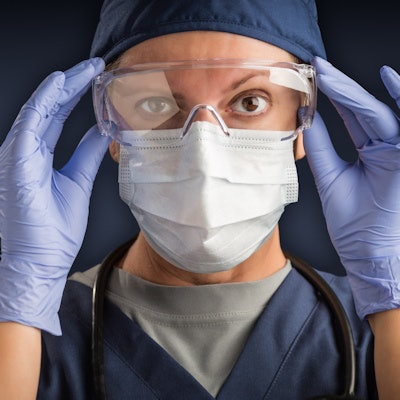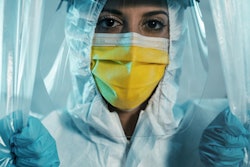
The use of personal protective equipment (PPE) varies among European radiologists who provide face-to-face ultrasound services, according to a survey study published on 31 January in Insights into Imaging.
A team led by Dr. Miraude Adriaensen, PhD, a radiologist from Zuyderland Medical Center in Heerlen, the Netherlands, said that its results indicate that more unified best practices are needed for radiologists, with PPE information added to standards and practice guidelines at medical facilities.
"Our results showed that harmonization on a European level regarding the recommended use of PPE for European radiologists providing face-to-face ultrasound services is lacking," said co-author Dr. Paolo Ricci from the Sapienza University of Rome to AuntMinnieEurope.com.
PPE use is an area of concern for radiologists, at least according to a 2020 report by the European Union of Medical Specialists. The researchers said healthcare providers in "many countries" have not been able to safely conduct ultrasound examinations; this has put them at risk of COVID-19 exposure.
"Whilst we did not yet fully understand this disease in July 2020, we did know that Black, Asian, and minority ethnic groups amongst medical practitioners and ancillary healthcare staff were amongst the highest mortality rates," they added.
Adriaensen, who is a member of the AuntMinnieEurope.com editorial advisory board, and her colleagues wanted to survey European radiologists to find out their PPE use when providing face-to-face ultrasound services. They looked at data from 46 survey participants representing delegates from the European Union of Medical Specialists. The participants represented 30 member countries of the union.
Out of the total, 38 survey respondents reported that they practice general ultrasound.
The respondents reported that all radiologists wore masks when it came to dealing with patients positive for COVID-19, with 12 wearing surgical masks, 18 wearing filtering facepiece (FFP) 2 masks, and 16 wearing FFP3 masks.
Most respondents reported that they used goggles (37/46), face shields (38/46), gowns (44/46), and gloves (45/46). However, plastic screen use was low at nine out of 46.
"In the free-text portion of the question one respondent expressed that in their department, full limb protection and double gloves were used as a precaution," the researchers wrote.
Results differed when it came to handling COVID-19 asymptomatic patients. Two survey respondents stated that doctors did not wear a face mask during appointments. Otherwise, surgical face masks were worn by 29 of the 46 respondents, with FFP2 (6/46) and FFP3 (21/46) comprising the rest.
Goggles were also worn by 21 clinicians while scanning asymptomatic patients, face shields worn by 20, and gowns worn by 27.
The researchers wrote that "some'' healthcare workers in the medical imaging department would use no PPE at all when scanning COVID-19 asymptomatic patients. They also added that in most departments, a negative polymerase chain reaction (PCR) test was needed to go through with an ultrasound examination.
The study authors called for all frontline healthcare workers to be given an appropriate quantity of sufficient-quality PPE for clinical settings to keep and make workers feel safe.
Ricci is president of the European Union of Medical Specialists Section of Radiology. He told AuntMinnieEurope.com that the section will suggest to the European Society of Radiology Ultrasound Subcommittee to add a paragraph on PPE for health professionals providing face-to-face ultrasound services to the best practice recommendations on ultrasound when the subcommittee position statements are revised.



















